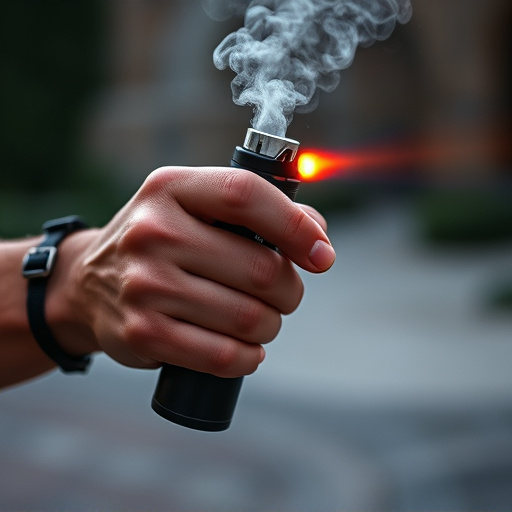Pepper spray, a non-lethal tactical defensive tool, effectively targets eyes and respiratory systems with capsaicin, causing pain and temporary blindness within 2-4 meters. Its range is influenced by user technique, environment (wind conditions, vegetative areas), spray formulation, and distance to target. Despite limitations due to weather and medical factors, pepper spray’s proven effectiveness against various assailants and growing global adoption by law enforcement highlight its enduring relevance in personal safety strategies.
Tactical inflammatory spray, or pepper spray, has become a ubiquitous self-defense tool. This article delves into its inner workings, focusing on understanding the active ingredients that trigger its powerful effects. We explore the factors influencing pepper spray range and effectiveness, analyzing distance and obstacles. Additionally, we examine real-world scenarios where it excels and identify limitations, providing an insightful overview of its effectiveness in enhancing personal safety.
- Understanding Pepper Spray: The Active Ingredients and Their Impact
- Pepper Spray Range: Factors Influencing Effective Distance
- Effectiveness in Real-World Scenarios: Success Stories and Limitations
Understanding Pepper Spray: The Active Ingredients and Their Impact
Pepper spray, also known as capsaicin spray, is a tactical defensive tool designed to incapacitate an assailant temporarily. Its primary active ingredient is capsaicin, a natural compound derived from chili peppers. This compound stimulates nerve endings in the eyes and respiratory system, causing intense irritation, pain, and temporary blindness. The impact of pepper spray can last for several minutes, enabling users to escape or subdue an attacker.
The effectiveness of pepper spray lies in its ability to disrupt an assailant’s balance and visibility, providing crucial time for self-defense or emergency services. The range of a typical pepper spray varies from 2 to 4 meters (6 to 13 feet), ensuring users can maintain a safe distance while still neutralizing the threat. This non-lethal weapon is widely used by law enforcement and civilians alike due to its rapid impact and relatively low risk of causing permanent harm.
Pepper Spray Range: Factors Influencing Effective Distance
The effective range of pepper spray, or tactical inflammatory spray, is a critical consideration for its defense capabilities. Several factors influence the distance at which it can be successfully deployed. One key element is the user’s breathing and movement; proper technique ensures the spray reaches the target area efficiently. Wind conditions play a significant role too; a headwind can extend the reach of pepper spray by carrying it further, while a tailwind might reduce its effectiveness as the spray dissipates faster.
The environment also impacts the range. In dense vegetation or confined spaces, the spray’s path may be obstructed, decreasing its effective distance. Conversely, open areas allow for better dispersion and greater reach. The type of pepper spray used matters too; different formulations have varying concentrations and spreading patterns, affecting their overall range and effectiveness.
Effectiveness in Real-World Scenarios: Success Stories and Limitations
Tactical inflammatory spray, commonly known as pepper spray, has been a popular defense system for individuals in various real-world scenarios. Its effectiveness lies in its ability to temporarily disable an attacker by causing severe irritation and discomfort in the eyes, nose, and throat. The range and effectiveness of pepper spray can vary based on factors such as the amount of active ingredients, wind conditions, and distance from the target. Success stories abound, with individuals using tactical inflammatory spray to deter and escape dangerous situations, including attacks from dogs, muggers, and even in self-defense against armed assailants.
However, limitations exist. Weather conditions can significantly impact its performance, as strong winds or heavy rain may reduce the spray’s effectiveness and range. Additionally, certain individuals, like those with respiratory conditions or sensitive skin, might experience more severe reactions. Moreover, pepper spray is not a permanent solution and requires the user to be within a specific range for optimal effect. Despite these constraints, tactical inflammatory spray remains a valuable tool in personal safety, as demonstrated by numerous success stories and its growing adoption by law enforcement agencies worldwide.
Tactical inflammatory spray, or pepper spray, is a powerful tool for self-defense, with its effectiveness largely dependent on understanding its range and nuances. The active ingredients, such as capsaicin, play a crucial role in creating a safe distance barrier against potential threats. While real-world scenarios have shown impressive success stories, there are limitations to consider, including weather conditions and target proximity. Optimizing the Pepper Spray Range can enhance its effectiveness, making it a valuable asset for personal safety in various situations.
